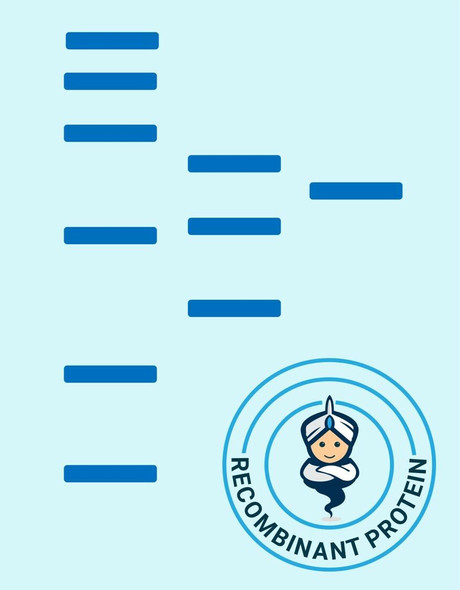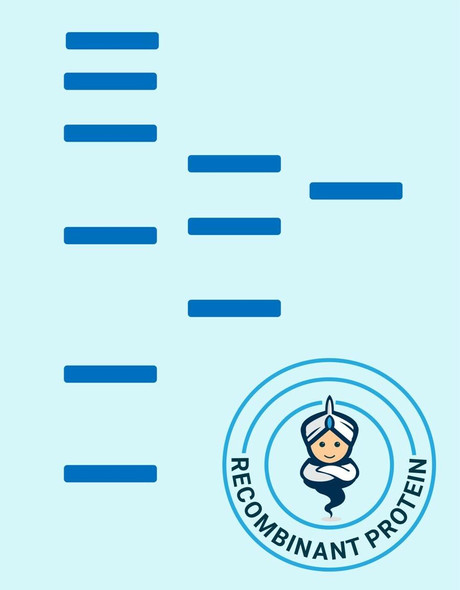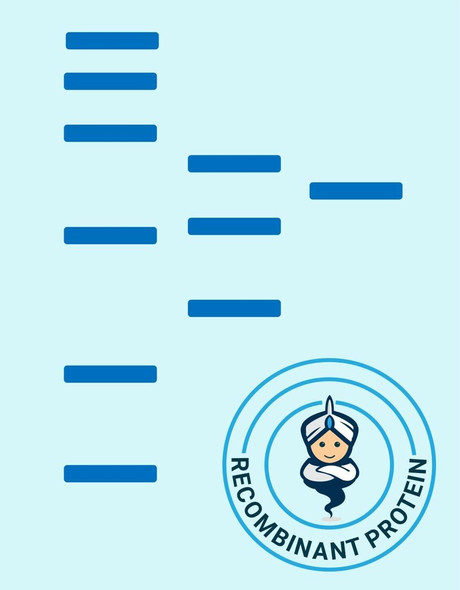Description
| Product Name: | Human ID2 Recombinant Protein |
| Product Code: | RPPB3734 |
| Size: | 20µg |
| Species: | Human |
| Target: | ID2 |
| Synonyms: | DNA-binding protein inhibitor ID-2, bHLHb26, GIG8, ID2A, ID2H, MGC26389, Class B basic helix-loop-helix protein 26, Inhibitor of DNA binding 2. |
| Source: | Escherichia Coli |
| Physical Appearance: | Sterile Filtered colorless solution. |
| Formulation: | ID2 protein solution (1mg/ml) contains 20mM Tris-HCl buffer (pH8.0), 10% glycerol and 0.4M Urea. |
| Stability: | Store at 4°C if entire vial will be used within 2-4 weeks. Store, frozen at -20°C for longer periods of time. For long term storage it is recommended to add a carrier protein (0.1% HSA or BSA).Avoid multiple freeze-thaw cycles. |
| Purity: | Greater than 85% as determined by SDS-PAGE. |
| Amino Acid Sequence: | MGSSHHHHHH SSGLVPRGSH MKAFSPVRSV RKNSLSDHSL GISRSKTPVD DPMSLLYNMN DCYSKLKELV PSIPQNKKVS KMEILQHVID YILDLQIALD SHPTIVSLHH QRPGQNQASR TPLTTLNTDI SILSLQASEF PSELMSNDSK ALCG |
Inhibitor of DNA Binding 2 (ID2) is a part of the inhibitor of DNA binding family, whose members are transcriptional regulators that contain a helix-loop-helix (HLH) domain but not a basic domain. Members of the ID family inhibit the functions of basic helix-loop-helix transcription factors in a dominant-negative way by suppressing their heterodimerization partners through the HLH domains. ID2 play a role in negatively regulating cell differentiation and may be an inhibitor of tissue-specific gene expression.
ID2 Human Recombinant produced in E.Coli is a single, non-glycosylated polypeptide chain containing 154 amino acids (1-134 a.a.) and having a molecular mass of 17kDa. ID2 is fused to a 20 amino acid His-tag at N-terminus & purified by proprietary chromatographic techniques.
| UniProt Protein Function: | ID2: ID (inhibitor of DNA binding) HLH proteins lack a basic DNA-binding domain but are able to form heterodimers with other HLH proteins, thereby inhibiting DNA binding. ID-2 may be an inhibitor of tissue-specific gene expression. Heterodimer with other HLH proteins. Interacts with GATA4, IFI204 and NKX2-5. Interacts with NR0B2. Highly expressed in early fetal tissues, including those of the central nervous system. |
| UniProt Protein Details: | Protein type:DNA-binding; Transcription, coactivator/corepressor Chromosomal Location of Human Ortholog: 2p25 Cellular Component: microtubule cytoskeleton; nucleoplasm; centrosome; protein complex; cytoplasm; nucleus; chromatin; cytosol Molecular Function:protein dimerization activity; protein binding Biological Process: regulation of lipid metabolic process; positive regulation of transcription, DNA-dependent; multicellular organismal development; positive regulation of smooth muscle cell proliferation; cell maturation; negative regulation of transcription from RNA polymerase II promoter; entrainment of circadian clock by photoperiod; locomotor rhythm; embryonic digestive tract morphogenesis; natural killer cell differentiation; negative regulation of osteoblast differentiation; circadian regulation of gene expression; positive regulation of macrophage differentiation; oligodendrocyte development; positive regulation of astrocyte differentiation; Peyer's patch development; negative regulation of B cell differentiation; transcription, DNA-dependent; negative regulation of transcription factor activity; positive regulation of erythrocyte differentiation; olfactory bulb development; neuron fate commitment; mammary gland epithelial cell proliferation; enucleate erythrocyte differentiation; regulation of circadian rhythm; negative regulation of DNA binding; negative regulation of oligodendrocyte differentiation; negative regulation of neuron differentiation; positive regulation of fat cell differentiation; negative regulation of transcription, DNA-dependent; metanephros development; positive regulation of blood pressure |
| NCBI Summary: | The protein encoded by this gene belongs to the inhibitor of DNA binding family, members of which are transcriptional regulators that contain a helix-loop-helix (HLH) domain but not a basic domain. Members of the inhibitor of DNA binding family inhibit the functions of basic helix-loop-helix transcription factors in a dominant-negative manner by suppressing their heterodimerization partners through the HLH domains. This protein may play a role in negatively regulating cell differentiation. A pseudogene of this gene is located on chromosome 3. [provided by RefSeq, Aug 2011] |
| UniProt Code: | Q02363 |
| NCBI GenInfo Identifier: | 729806 |
| NCBI Gene ID: | 3398 |
| NCBI Accession: | Q02363.1 |
| UniProt Related Accession: | Q02363 |
| Molecular Weight: | |
| NCBI Full Name: | DNA-binding protein inhibitor ID-2 |
| NCBI Synonym Full Names: | inhibitor of DNA binding 2, dominant negative helix-loop-helix protein |
| NCBI Official Symbol: | ID2�� |
| NCBI Official Synonym Symbols: | GIG8; ID2A; ID2H; bHLHb26�� |
| NCBI Protein Information: | DNA-binding protein inhibitor ID-2; helix-loop-helix protein ID2; cell growth-inhibiting gene 8; inhibitor of differentiation 2; DNA-binding protein inhibitor ID2; class B basic helix-loop-helix protein 26 |
| UniProt Protein Name: | DNA-binding protein inhibitor ID-2 |
| UniProt Synonym Protein Names: | Class B basic helix-loop-helix protein 26; bHLHb26; Inhibitor of DNA binding 2; Inhibitor of differentiation 2 |
| Protein Family: | DNA-binding protein inhibitor |
| UniProt Gene Name: | ID2�� |
| UniProt Entry Name: | ID2_HUMAN |






